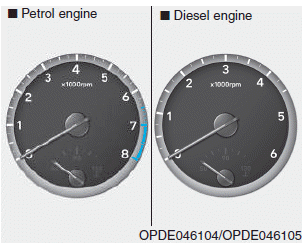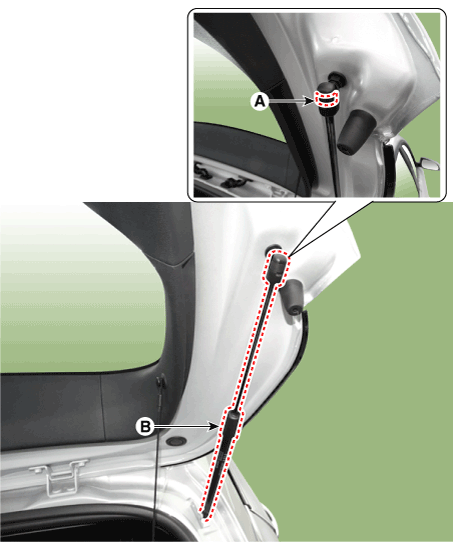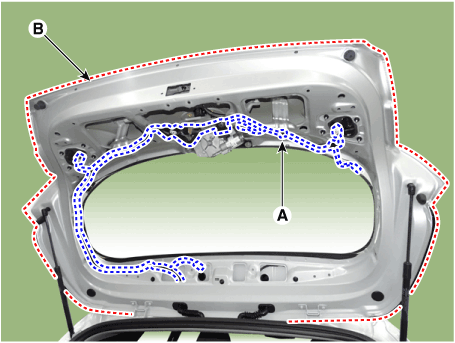Hyundai i-30: Tail Gate / Tail Gate Assembly
Hyundai i30 (PD) 2018-2025 Service Manual / Body (Interior and Exterior) / Tail Gate / Tail Gate Assembly
Components and components location
| Component Location |

| 1. Tail Gate
assembly |
Repair procedures
| Replacement |
|
|
| 1. |
Remove the tail gate trim.
(Refer to Tail Gate - "Liftgate Trim")
|
| 2. |
Using a screwdriver, lift the socket clips (A) up slightly on both ends
of the tail gate lifter (B).
|
| 3. |
Disconnect the connectors and tail gate wiring harness (A).
|
| 4. |
After loosening the mounting bolts, then remove the tail gate assembly
(B).
|
| 5. |
To install, reverse removal procedure.
|
 Repair procedures
Repair procedures
Adjustment
1.
Place the car on a flat surface and check whether the body and trunk
lid are well-aligned.
2...
 Tail Gate Trim
Tail Gate Trim
Components and components location
Component Location
1. Tail Gate
trim
Repair procedures
Replacement
[Tail Gate lower trim]
•
Put on gloves to prevent hand injuries...
Other information:
Hyundai i30 (PD) 2018-2025 Service Manual: Heater & A/C Control Unit (DATC)
Components and components location Components Connector [A] Pin NO Function Pin NO Function 1 Battery (+) 21 IGN2 2 ISG B+ 22 IGN1 3 ILL+ (TAIL) 23 Blower motor (+) 4 Sensor REF (+5V) 24 Photo sensor_LH 5 Mode actuator feedback 25 Photo sensor_RH 6 Temperature actuator feedback 26 - 7 Intake actuator feedback 27 - 8 EVAP Sensor (+) 28 PTC Relay 3 9 AMB Sensor (+) 29 PTC Relay 2 10 Mode actuator (Vent) 30 PTC on signal 11 Mode actuator (Defrost) 31 Detent OUT (-) 12 Temperature actuator (Cool) 32 - 13 Temperature actuator (Warm) 33 C_CAN High 14 Intake actuator (Fresh Air) 34 C_CAN Low 15 Intake actuator (Recirculated Air) 35 Power mosfet (Drain feed back) 16 HTD (Rear defog indicator) 36 Power mosfet (Gate) 17 Rear defog switch 37 ECV + 18 Clean signal 38 ECV- (Ground) 19 Ionizer diagnosis 39 Sensor ground 20 ILL- (RHEO) 40 Ground Connector [B] Pin NO Function Pin NO Function 1 Passenger's temperature control actuator (Feedback) 9 - 2 Passenger's temperature control actuator (Cool) 10 Duct sensor (+)_Vent 3 Passenger's temperature control actuator (Warm) 11 Duct sensor (-)_Floor 4 Auto defogging (Feedback) 12 Auto defogging sensor signal 5 Auto defogging (Open) 13 - 6 Auto defogging (Off) 14 - 7 - 15 - 8 - 16 Ground Repair procedures Self Diagnosis 1...
Hyundai i30 (PD) 2018-2025 Service Manual: Components and components location
Components [LHD] 1. ABS Control Module (HECU) 2. Front Wheel Speed Sensor 3. Rear Wheel Speed Sensor 4. ABS Warning lamp 5. EBD / Parking brake warning lamp [RHD] 1...
Categories
- Manuals Home
- 3rd Generation i30 Owners Manual
- 3rd Generation i30 Service Manual
- Engine coolant
- To activate the ISG system
- Theft-alarm system
- New on site
- Most important about car
Gauges and meters
Speedometer

The speedometer indicates the speed of the vehicle and is calibrated in kilometers per hour (km/h) and/or miles per hour (MPH).
Tachometer

Copyright © 2025 www.hi30.net





